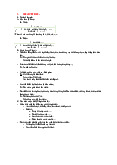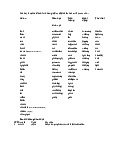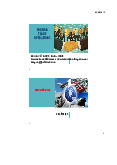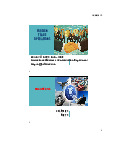



Preview text:
READING PASSAGE 1
You should spend about 20 minutes on Questions 1-13 which are based on Reading Passage 1 below. Cork
Cork – the thick bark of the cork oak tree (Quercus suber) – is a remarkable material. It
is tough, elastic, buoyant, and fire-resistant, and suitable for a wide range of purposes. It
has also been used for millennia: the ancient Egyptians sealed their sarcophagi (stone
coffins) with cork, while the ancient Greeks and Romans used it for anything from beehives to sandals.
And the cork oak itself is an extraordinary tree. Its bark grows up to 20 cm in thickness,
insulating the tree like a coat wrapped around the trunk and branches and keeping the
inside at a constant 20oC all year round. Developed most probably as a defence against
forest fires, the bark of the cork oak has a particular cellular structure – with about 40
million cells per cubic centimetre – that technology has never succeeded in replicating.
The cells are filled with air, which is why cork is so buoyant. It also has an elasticity that
means you can squash it and watch it spring back to its original size and shape when you release the pressure.
Cork oaks grow in a number of Mediterranean countries, including Portugal, Spain, Italy,
Greece and Morocco. They flourish in warm, sunny climates where there is a minimum
of 400 millimetres of rain per year, and not more than 800 millimetres. Like grape vines,
the trees thrive in poor soil, putting down deep roots in search of moisture and nutrients.
Southern Portugal’s Alentejo region meets all of these requirements, which explains why,
by the early 20th century, this region had become the world’s largest producer of cork,
and why today it accounts for roughly half of all cork production around the world.
Most cork forests are family-owned. Many of these family businesses, and indeed many
of the trees themselves, are around 200 years old. Cork production is, above all, an
exercise in patience. From the planting of a cork sapling to the first harvest takes 25
years, and a gap of approximately a decade must separate harvests from an individual
tree. And for top-quality cork, it’s necessary to wait a further 15 or 20 years. You even
have to wait for the right kind of summer’s day to harvest cork. If the bark is stripped on
a day when it’s too cold – or when the air is damp – the tree will be damaged.
Cork harvesting is a very specialised profession. No mechanical means of stripping cork
bark has been invented, so the job is done by teams of highly skilled workers. First, they
make vertical cuts down the bark using small sharp axes, then lever it away in pieces as
large as they can manage. The most skilful cork-strippers prise away a semi-circular husk
that runs the length of the trunk from just above ground level to the first branches. It is
then dried on the ground for about four months, before being taken to factories, where it
is boiled to kill any insects that might remain in the cork. Over 60% of cork then goes on
to be made into traditional bottle stoppers, with most of the remainder being used in the
construction trade. Corkboard and cork tiles are ideal for thermal and acoustic insulation,
while granules of cork are used in the manufacture of concrete.
Recent years have seen the end of the virtual monopoly of cork as the material for bottle
stoppers, due to concerns about the effect it may have on the contents of the bottle. This
is caused by a chemical compound called 2,4,6-trichloroanisole (TCA), which forms
through the interaction of plant phenols, chlorine and mould. The tiniest concentrations –
as little as three or four parts to a trillion – can spoil the taste of the product contained in
the bottle. The result has been a gradual yet steady move first towards plastic stoppers
and, more recently, to aluminium screw caps. These substitutes are cheaper to
manufacture and, in the case of screw caps, more convenient for the user.
The classic cork stopper does have several advantages, however. Firstly, its traditional
image is more in keeping with that of the type of high quality goods with which it has
long been associated. Secondly – and very importantly – cork is a sustainable product
that can be recycled without difficulty. Moreover, cork forests are a resource which
support local biodiversity, and prevent desertification in the regions where they are
planted. So, given the current concerns about environmental issues, the future of this
ancient material once again looks promising. Questions 1-5
Do the following statements agree with the information given in Reading Passage 1?
In boxes 1-5 on your answer sheet, write
TRUE if the statement agrees with the information
FALSE if the statement contradicts the information
NOT GIVEN if there is no information on this
1 The cork oak has the thickest bark of any living tree.
2 Scientists have developed a synthetic cork with the same cellular structures as natural cork.
3 Individual cork oak trees must be left for 25 years between the first and second harvest.
4 Cork bark should be stripped in dry atmospheric conditions.
5 The only way to remove the bark from cork oak trees is by hand. Questions 6-13 Complete the notes bolow. Choose
from the passage for each answer. ONE WORD ONLY
Write your answers in boxes 6-13 on your answer sheet.
Comparison of aluminium screw caps and cork bottle stoppers
Advantages of aluminium screw caps
• do not affect the ………… ………………… of the bottle contents 6
• are ………… ………………….. to produce 7
• are …………… ………………… to use 8
Advantages of cork bottle stoppers
• suit the ……… ……………………… of quality products 9 • made from a
……… ……………………… material 10 • easily
…… ………………………. 11
• cork forests aid 12………… ……………………… • cork forests stop
…………… …………………. happening 13
The classic cork stopper does have several advantages, however. Firstly, its traditional
image is more in keeping with that of the type of high quality goods with which it has
long been associated. Secondly – and very importantly – cork is a sustainable product
that can be recycled without difficulty. Moreover, cork forests are a resource which
support local biodiversity, and prevent desertification in the regions where they are
planted. So, given the current concerns about environmental issues, the future of this
ancient material once again looks promising. READING PASSAGE 2
You should spend about 20 minutes on Questions 14-26 which are based on Reading Passage 2 below. COLLECTING AS A HOBBY
Collecting must be one of the most varied of human activities, and it’s one that many of
us psychologists find fascinating. Many forms of collecting have been dignified with a
technical name: an archtophilist collects teddy bears, a philatelist collects postage stamps,
and a deltiologist collects postcards. Amassing hundreds or even thousands of postcards,
chocolate wrappers or whatever, takes time, energy and money that could surely be put to
much more productive use. And yet there are millions of collectors around the world. Why do they do it?
There are the people who collect because they want to make money – this could be called
an instrumental reason for collecting; that is, collecting as a means to an end. They’ll
look for, say, antiques that they can buy cheaply and expect to be able to sell at a profit.
But there may well be a psychological element, too – buying cheap and selling dear can
give the collector a sense of triumph. And as selling online is so easy, more and more people are joining in.
Many collectors collect to develop their social life, attending meetings of a group of
collectors and exchanging information on items. This is a variant on joining a bridge club
or a gym, and similarly brings them into contact with like-minded people.
Another motive for collecting is the desire to find something special, or a particular
example of the collected item, such as a rare early recording by a particular singer. Some
may spend their whole lives in a hunt for this. Psychologically, this can give a purpose to
a life that otherwise feels aimless. There is a danger, though, that if the individual is ever
lucky enough to find what they’re looking for, rather than celebrating their success, they
may feel empty, now that the goal that drove them on has gone.
If you think about collecting postage stamps, another potential reason for it – or, perhaps,
a result of collecting – is its educational value. Stamp collecting opens a window to other
countries, and to the plants, animals, or famous people shown on their stamps. Similarly,
in the 19th century, many collectors amassed fossils, animals and plants from around the
globe, and their collections provided a vast amount of information about the natural
world. Without those collections, our understanding would be greatly inferior to what it is.
In the past – and nowadays, too, though to a lesser extent – a popular form of collecting,
particularly among boys and men, was trainspotting. This might involve trying to see
every locomotive of a particular type, using published data that identifies each one, and
ticking off each engine as it is seen. Trainspotters exchange information, these days often
by mobile phone, so they can work out where to go to, to see a particular engine. As a by-
product, many practitioners of the hobby become very knowledgeable about railway
operations, or the technical specifications of different engine types.
Similarly, people who collect dolls may go beyond simply enlarging their collection, and
develop an interest in the way that dolls are made, or the materials that are used. These
have changed over the centuries from the wood that was standard in 16th century Europe,
through the wax and porcelain of later centuries, to the plastics of today’s dolls. Or
collectors might be inspired to study how dolls reflect notions of what children like, or ought to like.
Not all collectors are interested in learning from their hobby, though, so what we might
call a psychological reason for collecting is the need for a sense of control, perhaps as a
way of dealing with insecurity. Stamps collectors, for instance, arrange their stamps in
albums, usually very neatly, organising their collection according to certain
commonplace principles – perhaps by country in alphabetical order, or grouping stamps
by what they depict – people, birds, maps, and so on.
One reason, conscious or not, for what someone chooses to collect is to show the
collector’s individualism. Someone who decides to collect something as unexpected as
dos collars, for instance, may be conveying their belief that they must be interesting
themselves. And believe it or not, there is at least one dog collar museum in existence,
and it grew out of a personal collection.
Of course, all hobbies give pleasure, but the common factor in collecting is usually
passion: pleasure is putting it far too mildly. More than most other hobbies, collecting can
be totally engrossing, and can give a strong sense of personal fulfilment. To non-
collectors it may appear an eccentric, if harmless, way of spending time, but potentially,
collecting has a lot going for it. Questions 14-21
Complete the sentences below. Choose
from the passage for each answer. ONE WORD ONLY
Write your answers in boxes 14-21 on your answer sheet.
14 The writer mentions collecting …………………….. as an example of collecting in order to make money.
15 Collectors may get a feeling of …………………….. from buying and selling items.
16 Collectors’ clubs provide opportunities to share……………………………
17 Collectors’ clubs offer ………………………. with people who have similar interests.
18 Collecting sometimes involves a life-long………………………. for a special item.
19 Searching for something particular may prevent people from feeling their life is
completely……………………….
20 Stamp collecting may be ……………………….. because it provides facts about different countries.
21 ……………………….. tends to be mostly a male hobby. Questions 22-26
Do the following statements agree with the information given in the passage on pages 20 and 21?
In boxes 22-26 on your answer sheet, write
TRUE if the statement agrees with the information
FALSE if the statement contradicts the information
NOT GIVEN if there is no information on this
22 The number of people buying dolls has grown over the centuries.
23 Sixteenth century European dolls were normally made of wax and porcelain.
24 Arranging a stamp collection by the size of the stamps is less common than other methods.
25 Someone who collects unusual objects may want others to think he or she is also unusual.
26 Collecting gives a feeling that other hobbies are unlikely to inspire.




